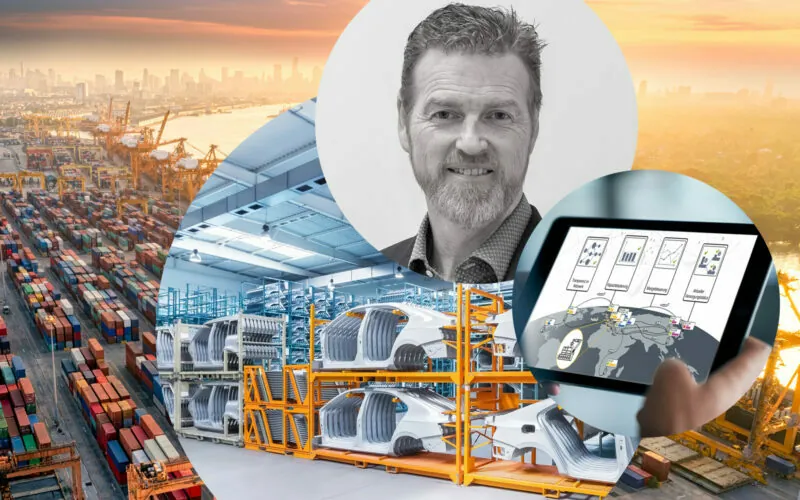Supplier management: 5 Questions for the Logistics Hero Ingo Hauptmann
August 31, 2020

August 31, 2020

Ingo Hauptmann, Segment Manager in the Supplier Management area at valantic, is one of the 2020 logistics heroes of the initiative “Die Wirtschaftsmacher.” In the interview, he explains how his experience as a forklift driver paved the way for this, what typical challenges he resolves for this customers, and which technologies will be crucial for supplier management in the future.
“Die Wirtschaftsmacher,” an initiative of German logistics companies, presents selected industry specialists in the form of hero stories on its own website. For the image of logistics in the public eye is, in the opinion of many industry representatives, in need of a serious upgrade. In order to publicize the services and many and varied activities in logistics, a comprehensive image campaign for logistics started in June 2019. With the Germany-wide image campaign “Logistics heroes,” Germany’s third-largest economic sector for young professionals and job seekers wants to score points and upgrade its image in the public eye. valantic is one of the early supporters of this campaign and has already presented two logistics heroes in 2019 (German version only).
One of the 2020 logistics heroes is Ingo Hauptmann, who manages the Supplier Management area in the Supply Chain Excellence division. As such, he regards himself as a “fireman” when something in the customer’s supply chain is “burning,” as he reveals in the following interview.
Hi Ingo, you’re one of the 2020 logistics heroes of the initiative “Die Wirtschaftsmacher”. What does this mean for you and what makes someone a logistics hero?
I’m happy that with this great initiative, I can draw more attention to the focal point of my work, namely supply management. For actually our work is usually done in the background and it is not visible to outsiders. As the manager of the Supplier Management area at valantic, I sometimes regard myself as a fireman. For if something in the customer’s supply chain is “burning,” we’re there. However, without the blue lights and siren.
My 15-person team and I have contributed to preventing a total of 50,000 minutes of production downtime and 5,000 extra trips, as well as the production of 30 tons of CO2. When we are called, after a situation analysis (that is: where it is burning?), we take immediate measures to limit the damage. For our primary goal is to keep the supply chain between the manufacturers and their suppliers from breaking down. At the critical moment, the customer may not find that his stocks are empty, which is why it’s our task to restore 100% supply reliability as quickly as possible.
On the one hand, in the individual projects there are also different views of precisely where supply chains have broken and who’s responsible for that. However, when push comes to shove, both sides always want the supply chain to run smoothly. Frequently, my team and I are the mediators between the parties, who analyze the processes and make recommendations for how communication could be improved. This also takes a good deal of composure.
Apropos many years’ experience. Weren’t you yourself a forklift driver? To what extent does that help you in supplier management?
I actually did work as a forklift driver and picker. I wouldn’t want to be without that experience, for that’s where I gained a lot of practical knowledge to complement my theoretical knowledge. For example, in being able to estimate planning, what will work and what does and doesn’t make sense. Furthermore, it makes communication and interaction with the employees on our customers’ job floor easier. That helps me, and indirectly also our customers, to understand where the shoe fits (or doesn’t) and what can be improved in order to optimize the supply chain on all levels.
What typical challenges and problems do customers generally bring to you and your team?
Even very large companies in the automobile industry, who are among our customers, experience many supply bottlenecks and problems. Frequently, things get stuck with the smallest parts; if, for example, production slows or even stops somewhere. The Corona pandemic, with its global production failures, clearly indicates how fragile supply chains can be. And the more global these supply chains are, the more difficult it is to guarantee 100% supply reliability. That’s why global monitoring of the supply chain and suitable defect control are so important.
If the number of production breakdowns increases, in these start-up phases, there can be bottlenecks with respect to the suppliers’ capacities and components. Supply management systems that focus exclusively on selection and monitoring processes and on sanctioned escalation levels are often no longer sufficient. Increasingly, practical, operative help on-site is required with which we as a supplier management team can assist customers and suppliers.
How does the cooperation between valantic, B2B customers, and the suppliers work at valantic, and how can these parties provide mutual support for one another when problems arise?
Here, valantic works with the manufacturer and-or the supplier in question where the problems were identified as a partner. We conduct a cause analysis on-site and then take immediate countermeasures. For our top priority is supply reliability. Here, it’s not just our IT and process expertise that’s in demand, it’s also our intermediary role as consulting team in order to ensure that there is a constructive, solution-oriented atmosphere between the manufacturer and the supplier. As soon as the immediate measures taken start to have some effect, we move on to problem-solving and adjustments, then to optimization of the processes in question. These can be the material flows, theoretical and actual throughput times, inventory bookings, the correct planning of production capacities, the flexibility of all productive forces, or all supply chain management including the connected IT systems. In follow-up projects, we work on the sustainability of the measures, frequently according to lean principles, or we recommend more extensive resource planning in order to increase flexibility in production and attune everything optimally to the customer’s needs. Help with self-help. Our work is well-done if it can go on without us.
Which solutions and services does valantic offer customers in the logistics sector? And which trends or technologies will be important in the future?
Given the many increasing material and auxiliary wage costs and the increasing incidence of variants, today we have to focus ever more on lean processes with storage times that are as short as possible and complete transparency along the entire supply chain. Previous SCM and ERP systems are definitively too monolithic and inflexible. What’s needed are flexible, digitalized cloud-based tools such as valantic’s Connected Chain Manager (CCM). With it, B2B customers not only achieve the required transparency in their entire supply chain, they also have a platform for supply chain collaboration. With the CCM, as many suppliers as desired can be connected and the entire supply network can be visualized with all relevant parameters. This transparency across levels and companies can be improved still further with the increased deployment of machine learning and artificial intelligence. Our goal is to avoid having to call the fire department.
But I don’t think that we supplier managers will be replaced by machines anytime soon, for experience and social competency are still a decisive factor here. We will continue to be on-site at our clients and their suppliers as a task force. However, perhaps we will no longer be surrounded by transport robots in production and warehouse, but rather by drones in goods delivery. Life will remain exciting in logistics and supplier management and I look forward to being able to help design both at valantic.
Thank you for taking the time to talk to us!

Our Webinar “Supply Chain Monitoring with the Connected Chain Manager”
Would you like to find out how you can benefit from the Connected Chain Manager and what potential there might be for optimizing your supply chain? In our free webinar…
Don't miss a thing.
Subscribe to our latest blog articles.